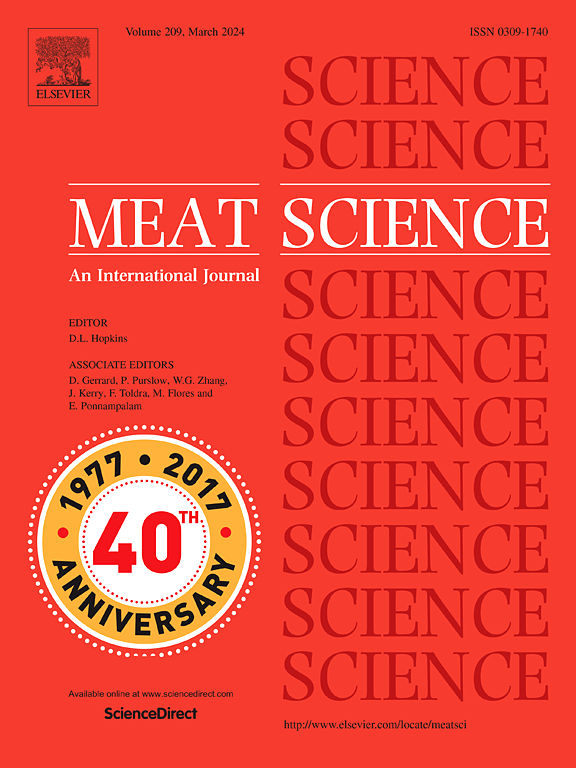一种创新的熟猪肉真空冷却方法:浸入式真空冷却和真空冷却之间的不间断操作
IF 6.1
1区 农林科学
Q1 Agricultural and Biological Sciences
引用次数: 0
摘要
为了解决冷却大型熟肉产品的挑战,我们开发了一种新的冷却方法:浸入式真空冷却和真空冷却(uo - ivc&vc)之间的不间断操作,并将其与传统方法(包括风冷(AB),真空冷却(VC)和浸入式真空冷却(IVC))的性能进行了比较。结果表明,在等压条件下,UO-IVC&;VC有效地整合了IVC和VC。UO-IVC&;VC将核心温度从72℃降至4℃所需时间为59.9 min,比VC (44.4 min)长,但比IVC (90.2 min)和AB (356.8 min)短(p <;0.05)。oo - ivc&;VC显著缩短了后期(20-4℃)的冷却时间至29.5 min,略快于VC (31.5 min) (p >;0.05)。vc处理后的样品失重率为3.81%,低于AB处理后的4.32% (p >;0.05)、VC (9.23%) (p <;0.05),略高于IVC (3.36%) (p >;0.05)。UO-IVC&;VC处理样品的颜色坐标(a*, L*)、弛豫时间T24、织构(Warner-Bratzler剪切力、硬度、胶度和嚼劲)介于VC和IVC之间,改善了颜色和质量。此外,UO-IVC&;VC、IVC和AB处理导致水分分布均匀,而VC、IVC和UO-IVC&;VC与AB相比,肌肉纤维结构略微紊乱。总之,UO-IVC&;VC在冷却大型熟肉制品方面具有有效应用潜力。本文章由计算机程序翻译,如有差异,请以英文原文为准。

An innovative method of vacuum cooling for cooked pork meat: Uninterrupted operation between immersion vacuum cooling and vacuum cooling
To address the challenges associated with cooling large, cooked meat products, we developed a novel cooling method: uninterrupted operation between immersion vacuum cooling and vacuum cooling (UO-IVC&VC) while comparing its performance with traditional methods, including air blast (AB), vacuum cooling (VC), and immersion vacuum cooling (IVC). Our results showed that UO-IVC&VC effectively integrated IVC and VC under isobaric conditions. The time required to reduce the core temperature from 72 to 4 °C with UO-IVC&VC was 59.9 min, longer than VC (44.4 min) but shorter than IVC (90.2 min) and AB (356.8 min) (p < 0.05). UO-IVC&VC significantly shortened the cooling time in the later phase (20–4 °C) to 29.5 min, which was slightly faster than VC (31.5 min) (p > 0.05). The weight loss rate for UO-IVC&VC-treated sample was 3.81 %, lower than that of AB (4.32 %) (p > 0.05) and VC (9.23 %) (p < 0.05), but slightly higher than IVC (3.36 %) (p > 0.05). The color coordinates (a*, L*), relaxation time T24, and texture (Warner-Bratzler shear force, Hardness, Gumminess and Chewiness) of UO-IVC&VC-treated sample were intermediate between VC and IVC, which improved color and quality. Additionally, UO-IVC&VC, IVC, and AB treatments resulted in uniform moisture distribution, while VC, IVC, and UO-IVC&VC exhibited slightly more disordered muscle fiber structures compared to AB. In conclusion, UO-IVC&VC demonstrates potential for effective application in the cooling of large, cooked meat products.
求助全文
通过发布文献求助,成功后即可免费获取论文全文。
去求助
来源期刊

Meat Science
工程技术-食品科技
CiteScore
12.60
自引率
9.90%
发文量
282
审稿时长
60 days
期刊介绍:
The aim of Meat Science is to serve as a suitable platform for the dissemination of interdisciplinary and international knowledge on all factors influencing the properties of meat. While the journal primarily focuses on the flesh of mammals, contributions related to poultry will be considered if they enhance the overall understanding of the relationship between muscle nature and meat quality post mortem. Additionally, papers on large birds (e.g., emus, ostriches) as well as wild-captured mammals and crocodiles will be welcomed.
 求助内容:
求助内容: 应助结果提醒方式:
应助结果提醒方式:


